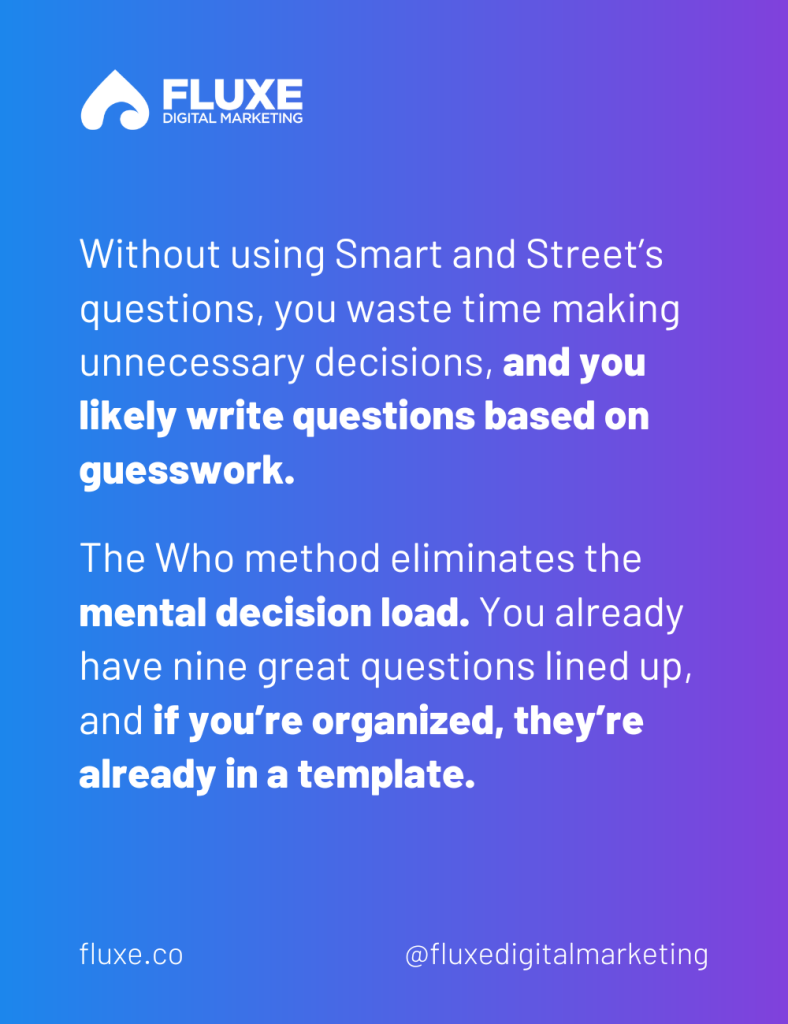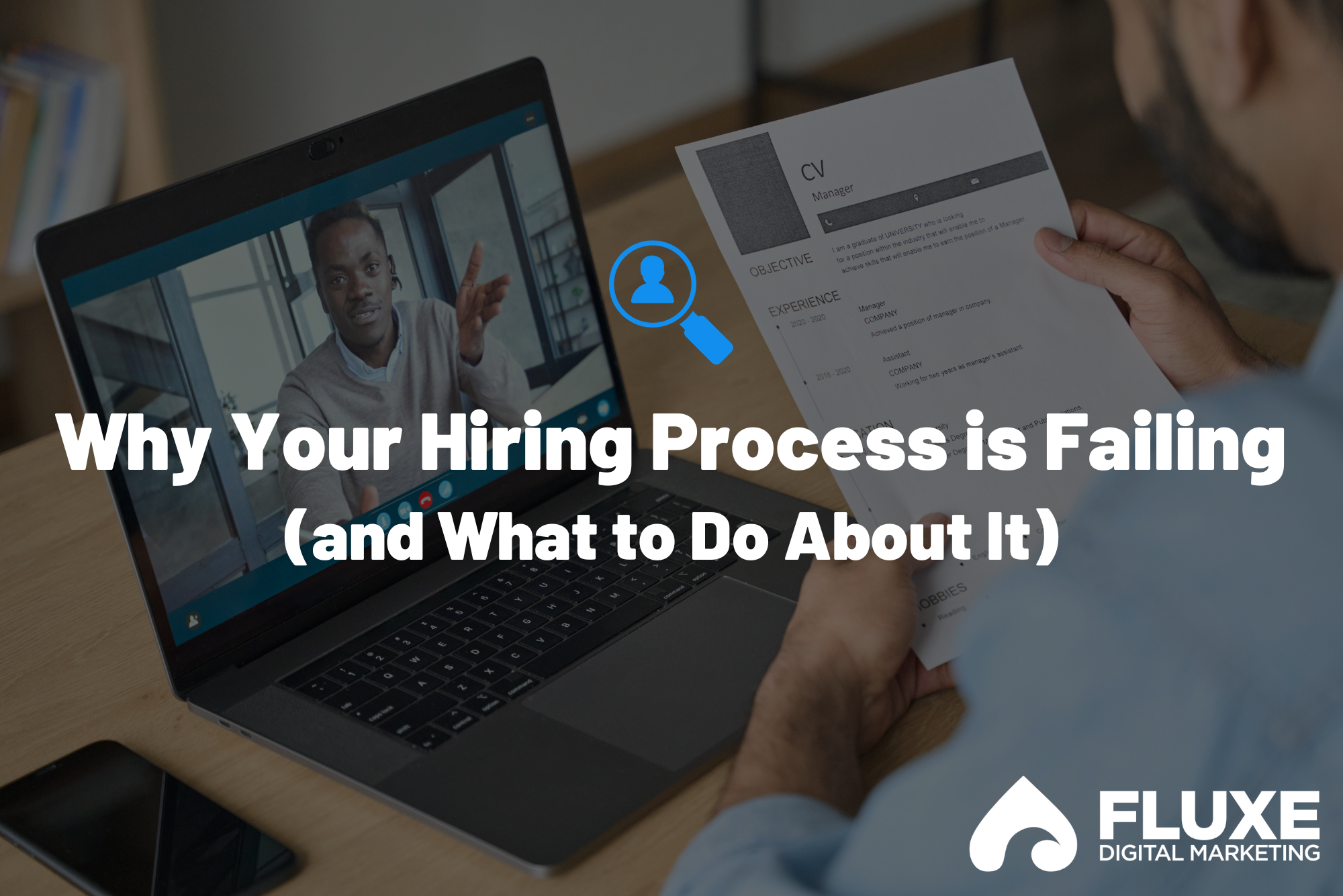Your hiring process doesn’t work.
Only 50% of recruitments across all businesses are successful, meaning both the hiring manager and the employee feel the employee is right for the company. We would know — for years, only half our hires stuck with us longer than 12 months.
Everything changed when we implemented our three-phase hiring process. Now, our recruitment is 90% effective, a statistic we’re proud of.
Not only do these hiring best practices have a higher success rate than any other process we’ve tried, but they also reinforce that every applicant is a human being — not a robot or a cog in a machine.

Our ‘Three-Legged’ Hiring Best Practices
An organized, efficient, and predictable hiring process brings kindness and respect to the workplace. It greatly impacts your company’s overall reputation and culture.
We liken our hiring process to a stool with three legs. Remove one of the legs, and the entire process fails.
Leg 1: The Who Method
Once we identify which applicants to pursue, those applicants move through the process outlined in the book “Who: The A Method for Hiring” by Geoff Smart and Randy Street. Though the book was written for filling executive positions, I’ve found it works for any type of hiring.
The Who method begins with a 15-minute screening, during which we ask four questions:
- What are your career goals?
- What are you really good at or interested in doing professionally?
- What are you not good at or not interested in doing professionally?
- On a scale of 1–10, how would your last three bosses rate your performance and why?
The candidates we decide to move forward with then proceed to an hour-long interview. We review each candidate’s career as outlined on their resume and ask five questions about each job, starting with the oldest and moving to the present day:
- What were you hired to do? Don’t assume this answer based on the candidate’s resume.
- What accomplishments are you most proud of? I’ve seen candidates break down in tears when answering this question. It puts the candidate in a grateful mindset and makes them feel safe, even if they were miserable at that job.
- What were some low points? If you keep your ears open, read between the lines, and ask follow-up questions, candidates will use this answer to tell you what kind of person they are. For example, if a candidate tells a story about a tense conversation with an ex-boss, I’ll follow up with a question like, “That sounds like an interesting conversation. How did it go?” The candidate’s answer will tell me how they approach challenges, for better or for worse.
- Who did you work with? You can gather a lot of information from the context clues of the candidate’s answer, whether it’s “I mainly worked with the CEO,” “I mainly worked with clients,” or “I didn’t work with anyone.”
- Why did you leave that job? Most of the time, the candidate answers this question unprompted. In this case, all you need to say is, “Just to make sure I heard you correctly, you left this job because [insert reason], is that correct?” Be attentive to the reason they give you. How they frame their experience (respectfully, avoidantly, warmly, etc.) tells you about their demeanor and how they communicate.
We ask each person the same questions, and we don’t try to amend or reinvent Smart and Street’s process. It’s been more successful and time-efficient than coming up with our own questions.
When I reject candidates after the hour-long Who interview, I’m often told, “If you’re hiring again, please keep me in mind. That was one of the best interviews I’ve had.” I credit the question, “What accomplishments are you most proud of?” A person’s self-image changes entirely when you put them in a grateful mindset.
Leg 2: The Culture Index
Not all personality assessments are created equal. Many of them diagnose traits irrelevant to the role, and sometimes candidates misrepresent themselves in an attempt to improve their chances of being hired.
That’s why I’m so passionate about the Culture Index. It doesn’t measure diagnosed mental ability or disability, moral compass/integrity, or skill, and unlike Myers-Briggs and the Sixteen Personality Factor Questionnaire, it doesn’t put candidates in boxes.
Rather, the Culture Index charts each candidate’s traits on a fluid graph. It accounts for several major variables and, through that, provides the best predictability as to how a candidate processes information, solves problems, and thinks of themselves in the context of a workplace.
The Culture Index answers the question, “What will set this person up for success?” and graphs that answer against the characteristics of the role. And if a candidate is fabricating answers to make them look more desirable, the Culture Index will tell me.
The Culture Index can also help you write a job posting tailored to the kind of person you’re trying to attract. For example, if I’m looking to hire someone detail-oriented, I put a ton of information in the job listing. If I’m looking for a high-level visionary, I exclude the nitty-gritty and stick to high-level goals.
Leg 3: The Test Project
Sometimes, we conduct the hour-long Who method interview last, but most of the time, a test project is the last step.
The test project is customized to the role — a marketing assistant will have a different test project than a copy editor — and matches a task or challenge the role faces daily. The simple question, “What would you do in this situation?” reveals a lot about a person. “I would ask my supervisor what to do,” “I would refer to Google,” and “I’d refer to the documentation and try to figure it out on my own” all tell me different things.
Someone may present fabulously in an interview but won’t execute a role-specific test project well. The test project allows you to get to know the candidate’s thought process and determine whether it matches their Culture Index results, your experience speaking with them, and your company’s needs.
Test projects also force you to define what success looks like in this role. What are your dealbreakers? What does accuracy look like? Is 90% success good enough?

Why These Hiring Best Practices Matter
Here’s what happens if you remove any of the three steps in our hiring process:
The Who Method
Without Smart and Street’s prewritten questions, you waste time making unnecessary decisions. You ask friends, coworkers, and even ChatGPT what questions to ask the candidate, and you likely write questions based on guesswork.
The Who method eliminates the mental decision load. You already have nine great questions lined up, and if you’re organized, they’re already in a template.
Before I implemented the Who method, my hires sometimes lasted less than four months. All my Who method hires have lasted at least a year — and counting!
The Culture Index
The Culture Index is one of the most helpful tools I use to understand the person I’m interviewing. I may not use it as heavily at the beginning of the hiring process, but its influence on final decision-making is undeniable.
Like the Who method, the Culture Index is a timesaver. Say you’ve narrowed your search to fourteen candidates. Instead of stringing them along through another round or two of interviews, you can refer to the Culture Index to help identify whose personality is the best match for the demands of the role and your company’s culture.
The Test Project
Until you give a candidate a test project, you don’t know how skilled they are. Sure, you can glean information from their resume and interview, but you haven’t seen their skills in practice.
Without a test project, you don’t know whether the candidate can do what they say they can — at least, not until after you’ve hired them. Then, if they fail to execute day-to-day tasks, you’ll either fire them or they’ll quit. Not only is the average cost to replace a terminated employee about 50% of that employee’s salary, but your time pursuing that candidate was also wasted.
In other words, if you care how much money or time you spend on hiring, give candidates a test project.
Hiring Best Practices: Software
One of the most important hiring best practices is to automate everything.
Use scheduling software to book interviews — we love Calendly — and candidate management software to organize applicants and send automated email responses. Our favorite is Workable. Without it, our process would get messy and overwhelming.
Video calling software is also non-negotiable (we use Zoom). Make sure you have a good transcription app, like Fathom, to take organized, accurate notes.
Final Hiring Best Practices
Eighty percent of the people I interview have recently been laid off. When I speak with them, they’re bruised, anxious, and vulnerable. Being able to meet them with kindness and treat them as human beings rather than inferiors is how I embody the ideals of compassion and respect at work.
Whether you use a similar three-legged stool process to ours or different hiring best practices altogether, don’t think of yourself as the one with the power. Put your ego aside and approach each candidate as a fellow human. You’ll be amazed at how successful your hiring process becomes.



